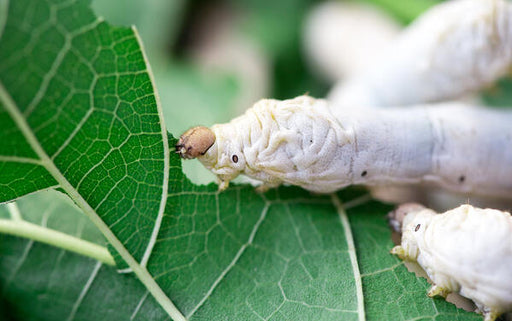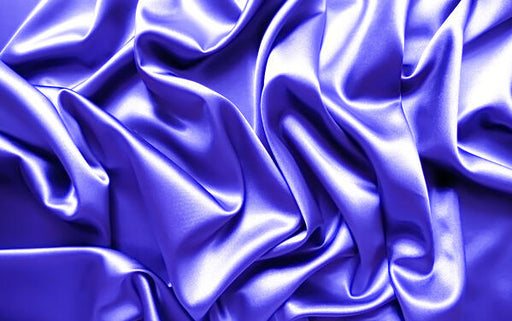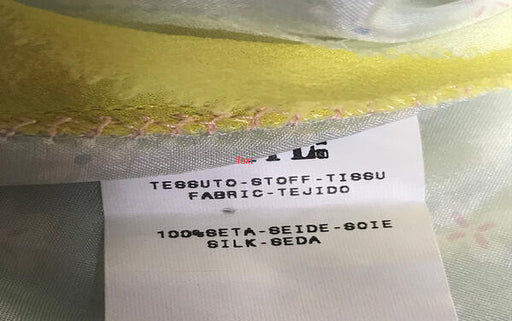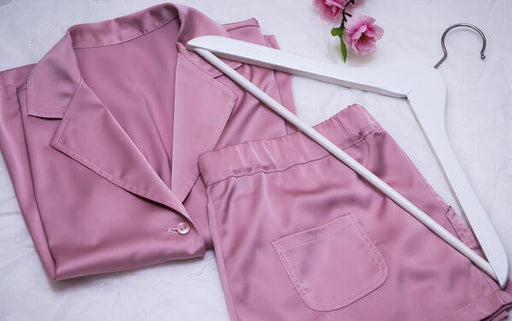What’s The Difference Between Satin And Silk

Are you confused by the differences between silk and satin — or why sometimes both names show up on a label? You’re not alone. Plenty of people mistake one for the other, or misunderstand the importance of defining a fabric by what it’s made from versus how it's woven into a textile. We’ll demystify all the nuances as we unpack everything you need to know about silk and satin.
What Is Silk?
We gather raw silk filament from various insects, but the most popular one is called the mulberry silkworm. As a natural, organic by-product, silk fibre contains all kinds of amino acids and is protected by a special protein layer. The hollow body of the fibre also insulates well - which is why people wear silk for warmth in the winter, but can also stay cool in it during the summer. Learn more about where silk comes from.
You may wonder if all silk is shiny on both sides? Not necessarily if you have a printed or woven silk item. With a silk weave the pattern will appear fuzzier on the reverse whereas a printed pattern will be much more evident on one side compared to the other.
The luxuriant look and feel of high quality silk fabrics add to the mystique and power associated with its reputation as a valuable symbol of status, but the cost of producing silk from thousands of silkworms is a major factor in its retail price. You can expect a cheap price tag to indicate low quality silk, or a silk blended with synthetic materials. Some silk blends can still wear and last with a similar quality as pure silk, though, and may be easier to launder.

What Is Satin?
When you see the word satin, you’re seeing a description of a weave, not a fibre — you may be familiar with twill, or even herringbone, which are also weaves rather than fibres. The way the threads are laid over others helps to define the name of the resulting textile, though the type of fibre used can also impact naming conventions. For satin, threads are woven in such a way that one side of the fabric has quite a bold sheen, while the other side winds up dull.
You may find the type of satin weave defined by how many times the yarn passes over itself before wrapping under to form the satin weave:
- 4-harness (4HS), more pliable than non-satin textiles
- 5-harness (5HS), mid-range pliability
- 8-harness (8HS), most pliable
- Antique
- Baronette
- Charmeuse
- Double-faced
- Duchess
- Faconne
- Venetian cloth
- Gattar
- Messaline
- Polysatin
- Slipper satin
- Sultan
- Surf satin
What Is Silk Satin?
Now, let’s put these two concepts together — silk, once woven to have a satin finish, is then called silk satin. As you can imagine, silk woven with a satin finish represents an ultimate luxury product. Not only does it have the suppleness of and natural shine of silk, but the weave also catches the light in a unique way. And, the buttery-smooth feel of the fabric against the skin makes this a perfect match for undergarments and bed linens where ultimate comfort is a necessity.

It should come as no surprise that silk satin is often priced at a premium. The tedious production process of silk is already costly, and while the secrets behind satin weaves have long been mastered by many, it’s still a highly specialized and highly prized skill. More than that, silk and satin are both difficult materials to work with when making clothes and other detail-heavy pieces. That expensive top at the shop came by its price through painstaking effort to keep this slippery material from puckering and bunching up on itself.
Silk vs Satin: Why Compare?
Because the front-facing weave of a satin textile looks so similar to the sheen of silk — and often feels just as supple — it can be easy to confuse the two at a glance. Textile manufacturers and clothing retailers may take advantage of this easy confusion and use inaccurate and unnecessary comparisons to funnel shoppers towards items they can charge more for even if they aren’t worth it. If someone tries to sell you satin as superior to silk, they don’t think you know the difference — or they don’t know it, in the first place. Either way, you may want to spend your money with a more reputable establishment.
Another reason we see silk and satin thrown in the ring together comes down to technical and historical points about what can and cannot be defined as satin when woven with a satin finish. Purists will say that only satin made with silk can be termed satin. This is why you may see clothes labelled as having a “satin finish”; in all likelihood, the material is not 100% silk.
But, it’s more and more common to see satin on a label whether or not the material has any silk in it. It’s safe to assume that clothing retailers want you to know when they’re using real silk with their satin-finish garments, so any label that leaves it a mystery may be trying to hide the way in which they cut some corners on the back-end.

That doesn’t mean satin-finish fabrics made from non-silk filaments are poor quality. Mid-range pieces that use a blend of natural and synthetic fibres offer an affordable opportunity to purchase garments of good quality, and ones that can withstand regular wash and dry cycles a little better than their all-natural counterparts.
Wearing And Caring For Satin Garments
Satin apparel spans the full range of garment types — we sleep, we play, we dance, we eat and we work while wearing satin. It could be just an accessory, like a neck-tie, or it could be a necessity, like a ballerina’s pointe shoe. We like to wear it close to our skin as underwear and negligee, and we also like to line our outerwear with it to ease the friction between the layers of our clothing while adding even more insulation.
Naturally, this fickle fabric requires a certain amount of caution when washing and drying it, especially when it’s made of silk or other natural fibres. Improperly handled, satin can develop permanent stains, become warped or even fray apart at vulnerable seams. Satin made from synthetic materials and blends may also be difficult to dye or colour-treat in any way, as synthetic fibres are not as porous as natural ones.
If your satin has any amount of natural fibre in its blend, you should follow all the usual steps you normally would when taking care of any garment that’s 100% natural fibre, like silk. Remember that although silk is the strongest natural filament used in garment-making, it loses a lot of that strength once wet. A satin finish doesn’t change this fact, although some textiles that blend silk with synthetic may be more resistant to damage.

Cool-water washes, mild detergents and no-heat drying techniques will keep your garments in good shape, as will smart storage solutions. It goes without saying that making sure your garments are completely dry before you pack them away for seasonal or short-term storage can prevent unsightly things like mould spots and mildew damage. But, the proteins from our hair and skin can stay trapped inside tightly woven fabrics like silk satins, which is just a snack waiting for a clothes moth to creep along and find.
Just like you would with your cashmere and merino wools, you should bring your satin items out of storage on occasion to give them a refresher-wash. Silk is also great at trapping perspiration stains that don’t show up until they’ve had time to yellow through oxidation. Give these items a vinegar soak for half an hour before thoroughly washing and drying them again. Use acid-free tissue paper between folded layers to keep everything breathable.
FAQs about Satin
Understanding all the mysteries behind the garments we wear makes a big difference in how we feel when we look at our closet or see ourselves in the mirror. When you're draping yourself in a luxurious satin, you'll feel all the more empowered knowing every detail behind its nuanced popularity.
Is polyester satin the same as silk?
The short answer is also an easy answer: no. Polyester, a synthetic material, can be made in such a way that, when woven with a satin finish, mimics many of qualities that attract consumers to silk satin. But, buyer-beware, this material isn’t breathable and won’t have the same wearability and durability as silk satin. It’s a great choice for costuming, however, since it only needs to look the part rather than be it in reality.
Is satin good to sleep in?
Many people love choosing satin made from silk for sleeping because the natural fibres help protect our hair and skin while we sleep. Due to the way our hair moves against silk without the kind of friction that causes dryness and breakage, silk bonnets are a popular choice at night. This is especially true for people who have curly hair that may be prone to more breakage than those with straight hair.

Which is softer, silk satin or satin made from other filaments?
Many pretenders try, but none can quite compare to high-quality silk that’s been woven with a satin finish. Those purists have a point when they say the only true satin is the kind made with silk — it is easy to claim it as a superior example of why this particular style of weaving is so prized and so popular. Accept nothing less! Unless your budget needs a break and you’ve found a high-quality blend that looks just as good as the 100% silk kind.
Which is cooler, silk satin or satin made from other filaments?
All natural fibres will be more breathable than synthetic ones, so a silk satin will always feel cooler to wear than any other kind of satin, even ones that use a filament-style fibre. Chalk this up to the natural biological function of silk. Like wool for sheep, it’s meant to regulate temperature for a silkworm in its cocoon.
Which is better, silk satin or satin made from other filaments?
This all comes down to your use and your preference, in the end, but it’s hard to argue against the rationale of the strict purists when it comes to the true tests of quality. Silk has retained its market value for centuries for good reason — it’s tough to improve on nature’s perfect design. However, good silk satin dupes are out there, and you’re the only one who will be able to tell the difference in most cases.
How can you tell the difference between silk satin or satin made from other filaments?
If your item lacks a label, or the label doesn’t make it clear, you may only have one option: the burn test. If you’re able to snip off a piece of inconspicuous fabric, like the inside seam allowance, then you can light an edge on fire and see how it burns. If it’s synthetic, the edge will curl and harden. If it’s natural, it will smoulder and crisp off once burnt. Fair warning, this is a trick that should only be done at home, by an adult in a safe setting.

You may only need to know how to understand the reasons why people argue differences between silk and satin for the occasional shopping spree, but it’s knowledge that can save you money in the long run. Or you win the jackpot, if you happen to find a trivia night where knowing silk is a material and satin is a weave proves to be the winning answer. Either way, we hope you use this information to help keep your closet stocked with quality pieces you can maintain easily for years to come.
Don't forget to take care of your silk clothes properly with our range of clothes moth traps.
About MothPrevention
MothPrevention® speak to customers every day about their clothes moth issues - clothes moths are a species that are ever increasing and that can cause significant damage to clothes, carpets and other home textiles.
To date, we’ve helped over 250,000 customers deal with their moth problems. We have developed professional grade solutions including proprietary pheromones and trap design engineered to the highest production standards.





